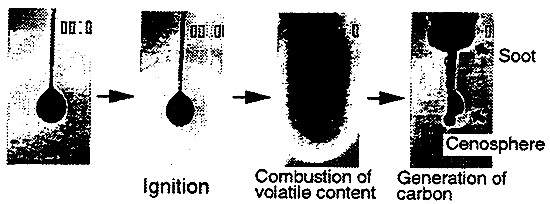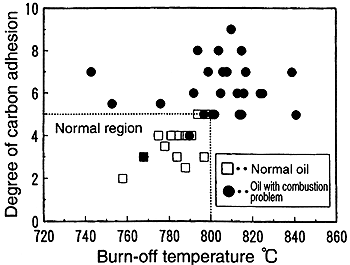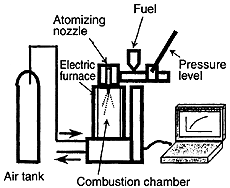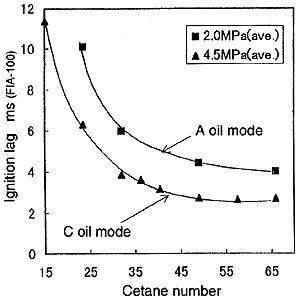
Fig.5 Photo of droplet combustion analysis
The carbon adhered to the upper part of the droplet holding part is of the vapor phase precipitation type, referred to as the soot, while the carbon left on the lower part is of the residual carbon type, referred to as the cenosphere. These carbons are classified in 5 ranks by the projected area, and their sum is defined as the degree of adhesion.
Fig. 6 shows the plotting of the relationship between the TG-DTA burn-out temperature and the degree of adhesion of carbon in the droplet combustion analysis for a normal oil and the sample oil which caused problems in combustion by the actual engine (problem in exhaust gas temperature, generation of smoke, generation of black smoke etc.). Though with several exceptions, it is judged roughly possible to judge and evaluate the normal oil and the oil with combustion problem by this curve.

Fig. 6 Evaluation of combustion-oil with combustion by laboratory evaluation method
(3) Ignition evaluation device (FIA-100: Fig. 7) This device records the ignition delay and the combustion speed when the fuel of approximately 0.1 ml is injected into the combustion chamber of constant volume filled with air of 1 liter in volume, 4.5 MPa in pressure and 450℃ in temperature. More specifically, the pressure in the combustion chamber is recorded by each 0.02 ms after the injection of the fuel to the time point of 0.1 second thereafter, and the ignition delay can be obtained from the time when the pressure is rapidly increased. Fig. 8 shows the relationship between the cetane number of the standard sample obtained by mixing cetane (cetane number 100) with (cetane number 15) and the ignition delay obtained by the FIA-100. There is a correlation to be expressed by the appropriate expression between the cetane number and the ignition delay both for the case of 2.0 MPa (A oil mode) in the pressure in the combustion chamber and the case of 4.5 MPa (C oil mode). In particular, the response is excellent in a region below 50 in cetane number.

Fig. 7 Outline of ignition evaluation device (FIA-100)
Thus, it is believed to be possible to evaluate the ignitionability (cetane number) from the sample of a small amount if this device is used. Fig. 9 shows the result of evaluation of light cracked oil (LCO) and cetane. These are the histograms in 10 trials, respectively. The comparison shows that cetane is small in mean ignition delay and excellent in ignitionability. The variance of cetane is smaller. The influence of this variance on the performance of the engine is not clear, and it is one of the problems to be examined in future.

Fig. 8 Relationship between cetane number and FIA-100
BACK CONTENTS NEXT